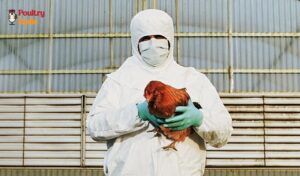Mycoplasmosis Meltdown: Mycoplasmosis in Chickens and the Ultimate Defense Plan
Mycoplasmosis in chickens or mycoplasma gallisepticum (MG) disease, commonly referred to as mycoplasmosis, is a group of bacterial infections brought on by different Mycoplasma species. Due to the absence of a cell wall, these bacteria are distinct and resistant to many popular antibiotics which target cell walls.

Poultry like chickens and turkeys, are highly susceptible to mycoplasma infections. Various Mycoplasma species may infect poultry, but Mycoplasma gallisepticum (MG) and Mycoplasma synoviae (MS) are two of the most significant.
What is Mycoplasmosis in Chickens (MG, Chronic Respiratory Disease)?
Mycoplasma gallisepticum primarily affects the respiratory system of the bird. It is a highly contagious disease among poultry, spreading through direct contact with infected birds, contaminated equipment, and airborne transmission through respiratory secretions. Despite the possibility of some birds developing immunity, infected birds become carriers and are contagious for life.
Epidemiology and Transmission of Mycoplasma gallisepticum Infection
Mycoplasma gallisepticum can be transmitted vertically within certain eggs (transovarian) from infected breeders to offspring, and horizontally through infectious aerosols as well as contamination of feed, water, and the environment. Additionally, human activity on fomites such as shoes and equipment can also contribute to the spread. Infection may remain latent in some birds for days to months, but when birds are stressed, horizontal transmission can occur rapidly via aerosols and the respiratory route. Subsequently, infection and clinical disease can spread throughout the flock.
Once birds or flocks become infected, they stay infected for life and can spread the infection to others. The infection can easily spread from one flock to another through contact or movement of birds, people, or contaminated objects from infected to susceptible flocks.
The conjunctiva, nasal passages, sinuses, and trachea epithelium are particularly susceptible to initial colonization and infection. In severe, acute disease, the bronchi, air sacs, and occasionally lungs may also become infected. Once infected, birds may remain carriers for life. The pathogenesis and severity of chronic respiratory disease involve a significant interaction (polymicrobial disease) between respiratory viruses, Escherichia coli, and M. gallisepticum.
Symptoms of Mycoplasma Genitalium in Chickens
The clinical signs are similar to those seen with numerous other avian respiratory infections (Infectious Bronchitis, New Castle Disease, Infectious Coryza). They include:
- Foamy eyes and swollen eyelids. They may have eye discharge that smells and is visible on their face or feathers.
- Coughing
- Sneezing
- Nasal discharge
- Ocular discharge
- Gasping
Bubbly clear fluid or foamy discharge is seen in the eyes. In young broilers, signs are more severe than adults. Major decrease in egg production in laying birds.

Lesions of Mycoplasma Genitalium or CRD?
- Swelling or inflammation of sinuses, nasal passage, trachea, and bronchi.
- Thickening of air sacs and may contain mucoid or caseous exudates.
- Recent vaccinations against infectious bronchitis or Newcastle disease may make air sacs more opaque.
- Fibrinous perihepatitis (Cheezies layer of fibrin on the liver)
- Inflammation and the development of adhesive pericarditis.
Diagnosis of Mycoplasma gallisepticum Infection in Poultry
Real-time PCR is increasingly utilized for diagnosing infections.
History, clinical signs, and typical gross lesions can indicate M gallisepticum infection, with serology by agglutination and ELISA methods commonly used for surveillance. Hemagglutination inhibition is employed as a confirmatory test due to potential nonspecific false agglutination reactions, particularly following injection of inactivated oil-emulsion vaccines or infection with M synoviae.
Mycoplasma gallisepticum should be verified by isolating it from swab samples taken from the infraorbital sinuses, nasal turbinates, choanal cleft, trachea, air sacs, lungs, or conjunctiva.
Mycoplasma isolates must be specifically identified by species, as birds may also be affected by nonpathogenic mycoplasmas. In addition, when considering the differential diagnosis, it is important to include E. coli infection, Newcastle disease, and Avian Influenza, as well as other respiratory diseases such as Infectious Bronchitis in chickens, as they may act as inciting or contributing pathogens.
What is Mycoplasma Synoviae Infection (MS, Infectious Synovitis)?
Mycoplasma synoviae (MS) infection is also caused by Mycoplasma species. this disease primarily affects the joints and respiratory systems of birds. Like Mycoplasma Gallisepticum, MS also can transmit vertically through infected hens to their offspring. The other ways of it spared are through direct contact with affected birds, contaminated equipment, and airborne transmission through respiratory secretions.
M synoviae is transmitted via eggs (transovarian), but the prevalence of infection in breeder hens is minimal, and some offspring batches may be free of the infection. Horizontal transmission closely resembles that of M gallisepticum, mainly occurring through the respiratory tract via both direct and indirect means.
Clinical Signs of Mycoplasma Synoviae (MS)
- Early signs of infectious synovitis typically manifest as pale-blue discoloration in the head region and lameness in numerous birds, often accompanied by a preference to remain seated.
- Swollen hock or feet pad.
- Thick yellow pus in the eye sockets and sinuses.
- Morbidity is low to moderate and can be increased in the case of wet litter and damp conditions.
Postmortem Lesions
- In the early phase of synovitis, joints and tendon sheaths contain sticky, viscid, and gray to yellow exudates.
- In the later stages, Joint surfaces may get discolored orange or yellow by exudate in joints and tendon sheaths.
- Respiratory lesions may be mild mucoid tracheitis, airsacculitis, or sinusitis, lesions that are usually associated with M. gallisepticum infection (chronic respiratory disease).
Diagnosis of Mycoplasma synoviae Infection in Poultry
Real-time PCR is increasingly utilized as the primary diagnostic test.
It is crucial to rule out skeletal abnormalities and trauma as potential causes of lameness. Possible differential diagnoses comprise viral tenosynovitis, staphylococcal, and other bacterial joint infections, as well as respiratory pathogens such as New Castle disease virus, Infectious Bronchitis virus, and Mycoplasma Galisepticum.
Prevention and Control of Mycoplasmosis
- Implement strict biosecurity measures to prevent the introduction and spread of mycoplasma infections.
- Regular testing for MG can play a key role in minimizing its spread.
- Vaccination against mycoplasma infections is available for certain strains and can help reduce the severity of symptoms and the spread of the disease.
- Purchase mycoplasma-free birds.
- Avoid environmental stress on birds (Chilling or any kind of temperature fluctuations).
Mycoplasma Gallisepticum Treatments
Antibiotics can reduce clinical manifestations and vertical transmission, yet they do not eliminate the infection.
- The use of Tiamulin or Tylosins is highly recommended in the case of CRD. Doxycycline and tetracyclines are also effective against MG infections.
- Providing fresh crushed garlic in feed or water helps boost the immune system.
- Providing apple cider vinegar in drinking water (5ml per liter) which acts as a natural immune booster (do not use in a metal drinker).
Frequently Asked Questions
What are the symptoms of Mycoplasma in poultry?
Foamy eyes, swollen eyelids. They may have eye discharge that smells and is visible on their face or feathers.
Coughing
Sneezing
Nasal discharge
Ocular discharge
Gasping
Bubbly clear fluid or foamy discharge is seen in the eyes. In young broilers, signs are more severe than adults. Major decrease in egg production in laying birds.
How do you treat mycoplasma infection?
The use of Tiamulin or Tylosins is highly recommended in the case of CRD. Doxycycline and tetracyclines are also effective against MG infections.
How do you treat Mycoplasma in chickens naturally?
Providing fresh crushed garlic in feed or water helps boost the immune system.
Providing apple cider vinegar in drinking water (5ml per liter) which acts as a natural immune booster (do not use in a metal drinker).
How is Mycoplasma spread in chickens?
Mycoplasma gallisepticum can be transmitted vertically within certain eggs (transovarian) from infected breeders to offspring, and horizontally through infectious aerosols as well as contamination of feed, water, and the environment. Additionally, human activity on fomites such as shoes and equipment can also contribute to the spread.
What is the Mycoplasma vaccine for chickens?
Poulvac Myco F has demonstrated efficacy in vaccinating healthy chickens aged 9 weeks or older against M. gallisepticum bacteria.
Is mycoplasma in chickens contagious to humans?
No, Mycoplasma does not make people sick. However, if you are around sick birds, you may spread the bacteria to other birds!
If birds have Mycoplasma, can we still eat the eggs?
Yes, the eggs are still safe to eat, as long as the birds are not given antibiotics.








